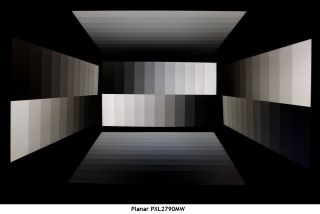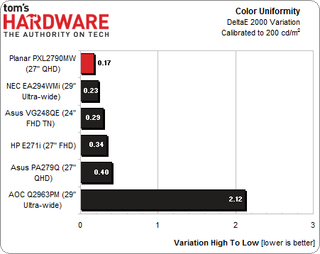Planar 27" QHD Monitor Review: Clarity Like We've Never Seen
Planar sent over its newest QHD screen, the 27" PXL2790MW. This is the sharpest display we’ve ever seen, and one of the most accurate. With high-end styling and a 2560x1440 native resolution, it introduces a sense of luxury to the business class.
Results: Viewing Angle And Uniformity
Built around an LG-made AH-IPS panel, the PXL2790MW should give us comparable off-axis viewing performance to other IPS panels we’ve tested. We wondered if the layer bonding technology used by Planar might affect the results.

While there is very little light falloff, you can see a slight color shift towards red and green in the side-angle photos. Since all of the light coming from an LCD panel is polarized, the various color wavelengths shift differently as the eye moves from the polarizing grid’s axis. On this monitor, not only is the LCD bonded directly to the front protective layer, but a chemical anti-glare coating is applied as well. This coating has optical properties that contribute to the PXL2790MW’s superb clarity and crispness, but exact a slight cost in off-axis image quality.
Screen Uniformity: Luminance
To measure screen uniformity, zero percent and 100 percent full-field patterns are used, and nine points are sampled. In a change from previous reviews, we’re now comparing the results to other monitors we’ve measured. First, we establish a baseline measurement at the center of each screen. Then the surrounding eight points are measured and their values expressed as a percentage of the baseline, either above or below. This number gets averaged. It is important to remember that we only test the review sample each vendor submits. Other examples of the same monitor can measure differently in this metric.
First up is black field uniformity.

This is the PXL2790MW’s only real flaw, and we believe it’s a result of the bonding process used to eliminate the air gap between the LCD and front panel layers. The hot spots are most visible in the upper left, followed by the center and lower left. The lower-right corner also runs slightly brighter than the rest of the screen.
Here’s the white field measurement.

At the other end of the brightness scale, the Planar measures almost perfectly. Such a low uniformity error is pretty much invisible. In fact, it’s the third-best result we’ve recorded this year.
Stay on the Cutting Edge
Join the experts who read Tom's Hardware for the inside track on enthusiast PC tech news — and have for over 25 years. We'll send breaking news and in-depth reviews of CPUs, GPUs, AI, maker hardware and more straight to your inbox.
Screen Uniformity: Color
To measure color uniformity, we display an 80-percent white field and measure the Delta E error of the same nine points on the screen. Then we simply subtract the lowest value from the highest to arrive at the result. A smaller number means a display is more uniform. Any value below three means that variation is invisible to the naked eye.

The PXL2790MW’s performance here is even better than its white field luminance test. A .17 Delta E variation is completely undetectable to the eye. It’s almost as small as our i1Pro’s measurement tolerance. The layer bonding process seems to have a positive effect in this test case.
Current page: Results: Viewing Angle And Uniformity
Prev Page Results: Color Gamut And Performance Next Page Results: Pixel Response And Input Lag
Christian Eberle is a Contributing Editor for Tom's Hardware US. He's a veteran reviewer of A/V equipment, specializing in monitors. Christian began his obsession with tech when he built his first PC in 1991, a 286 running DOS 3.0 at a blazing 12MHz. In 2006, he undertook training from the Imaging Science Foundation in video calibration and testing and thus started a passion for precise imaging that persists to this day. He is also a professional musician with a degree from the New England Conservatory as a classical bassoonist which he used to good effect as a performer with the West Point Army Band from 1987 to 2013. He enjoys watching movies and listening to high-end audio in his custom-built home theater and can be seen riding trails near his home on a race-ready ICE VTX recumbent trike. Christian enjoys the endless summer in Florida where he lives with his wife and Chihuahua and plays with orchestras around the state.
-
stoogie 16.2ms SMTT reviewed catleap or crossovers from greensum/korea LG S-IPS have been out for well over 2 years now at a $300 or less starting price. Get with the times toms.Reply -
Bondfc11 I agree with stoogie - also Toms needs to get an Overlord tempest and take a look at a real gaming 1440 panel that can do up to 120hz refresh rates. This screen isn't that special and the housing has been around in other variants for a year now as well.Reply -
tpi2007 445 cd/m2 of luminance as maximum and 174.7655 cd/m2 as minimum ? Why do monitor manufacturers insist on delivering brighter and brighter monitors ? People don't use them like they are on display in a very well lit showroom, if you want to use one of these at home with just an indirect light source on the wall for some gaming at night, you're out of luck, this doesn't even reach the industry standard of 120 cd/m2 as adequate regular brightness, let alone the 50 cd/m2 that Tom's and many others consider an acceptable minimum to have in a darker room.Reply
-
s3anister Reply12033250 said:no award?
What do you seriously think that another 27" 2560x1440 60Hz monitor that is already in class with a dozen other models identical to it, deserves an award? -
DarkSable Looks exactly like the "new" QHD Iiyama. Doesn't perform well. Costs a lot. What's the advantage, again?Reply
As for those overlord monitors, I wasn't impressed by them, mostly because I had it sitting next to a lightboost 2 120hz TN panel. Yes, the overclocked IPS panel has better colour (though that's largely negated by using it on minimal brightness in a dark room, like we've already been talking about), and it's certainly pretty and gives a lot of screen real estate... but it can't compare to a real 120Hz monitor, especially not one with a strobing backlight. -
WyomingKnott "With the new PXL2790MW, we quickly discovered there was no need for scaling in any program. The image is so clear that even the smallest text is fully legible." Technically admirable, but not enough for people like me with middle-aged eyes. The more pixels per inch, the happier my eyes are, but they still want decent-sized fonts.Reply
Now this sort of monitor clarity plus an OS that supports decent enlarged fonts would be really nice. Apps that scale well over a range of sizes would be even nicer. A 1000 pixel wide frame may be good for some people no matter how small it is; others of us would like at least a certain number of inches. Support all of us.
(Yes, I know that this isn't the monitor's fault. It's a poor convention in many parts of the software industry.) -
warezme I have never had a major problem with text clarity with pretty much any LCD since the first thing I make sure to do is set the panel or monitor to native resolution hardware scaling and turn off all windows text or font smoothing and windows set to the same monitor native resolution. I haven't seen one of these 2560 screens in person but I have experienced the default font issue that happens when you try and let windows smooth or scale. I don't like monitors with radiused corners because that makes the bezels even thicker then they need to be. I also don't like the way most monitor manufacturer try to hide the input plugs by making them inset and pointing down. It is a pain to try to plug or unplug anything when you can't see the plug without laying the monitor on its side. Also it makes no use to label the inputs if they are inset dark on dark. Make the text white.Reply -
-Fran- This deserves a "meh" award at most.Reply
QHD is not ready for gaming prime time yet, sorry folks.
Cheers!
Most Popular

